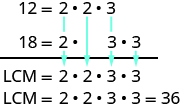how do you find the least common multiple
Learning Outcomes
- Find the to the lowest degree common multiple of two numbers past listing multiples
- Detect the least mutual multiple of ii numbers by prime factorization
One of the reasons we find multiples and primes is to use them to discover the least common multiple of two numbers. This volition be useful when we add and subtract fractions with different denominators.
Listing Multiples Method
A common multiple of two numbers is a number that is a multiple of both numbers. Suppose we desire to find common multiples of [latex]10[/latex] and [latex]25[/latex]. Nosotros can list the get-go several multiples of each number. Then we look for multiples that are common to both lists—these are the common multiples.
[latex]\begin{array}{c}10\text{:}ten,20,xxx,40,50,60,70,80,90,100,110\ldots \hfill \\ 25\text{:}25,l,75,100,125\ldots \hfill \end{array}[/latex]
We see that [latex]l[/latex] and [latex]100[/latex] appear in both lists. They are common multiples of [latex]10[/latex] and [latex]25[/latex]. Nosotros would find more common multiples if nosotros continued the listing of multiples for each.
The smallest number that is a multiple of two numbers is called the to the lowest degree common multiple (LCM). And so the least LCM of [latex]10[/latex] and [latex]25[/latex] is [latex]fifty[/latex].
Find the least common multiple (LCM) of 2 numbers by listing multiples
- List the first several multiples of each number.
- Expect for multiples common to both lists. If there are no mutual multiples in the lists, write out additional multiples for each number.
- Await for the smallest number that is common to both lists.
- This number is the LCM.
case
Discover the LCM of [latex]fifteen[/latex] and [latex]20[/latex] by listing multiples.
Solution:
List the outset several multiples of [latex]15[/latex] and of [latex]xx[/latex]. Place the first common multiple.
[latex]\begin{assortment}{l}\text{15: }15,30,45,threescore,75,ninety,105,120\hfill \\ \text{20: }20,twoscore,sixty,80,100,120,140,160\hfill \end{array}[/latex]
The smallest number to appear on both lists is [latex]lx[/latex], and then [latex]lx[/latex] is the to the lowest degree mutual multiple of [latex]15[/latex] and [latex]20[/latex].
Observe that [latex]120[/latex] is on both lists, also. It is a mutual multiple, merely it is not the least mutual multiple.
endeavour it
In teh next video nosotros show an example of how to detect the Least Common Multiple by listing multiples of each number.
Prime number Factors Method
Another way to find the least common multiple of 2 numbers is to employ their prime number factors. We'll use this method to find the LCM of [latex]12[/latex] and [latex]eighteen[/latex].
Nosotros showtime by finding the prime factorization of each number.
[latex]12=ii\cdot 2\cdot 318=2\cdot three\cdot iii[/latex]
Then we write each number every bit a product of primes, matching primes vertically when possible.
[latex]\brainstorm{array}{l}12=2\cdot ii\cdot 3\hfill \\ 18=ii\cdot iii\cdot three\end{array}[/latex]
At present we bring down the primes in each column. The LCM is the production of these factors.

Observe that the prime number factors of [latex]12[/latex] and the prime factors of [latex]18[/latex] are included in the LCM. Past matching up the mutual primes, each common prime number factor is used but once. This ensures that [latex]36[/latex] is the least mutual multiple.
Find the LCM using the prime factors method
- Observe the prime factorization of each number.
- Write each number as a product of primes, matching primes vertically when possible.
- Bring down the primes in each column.
- Multiply the factors to get the LCM.
example
Find the LCM of [latex]15[/latex] and [latex]18[/latex] using the prime factors method.
case
Discover the LCM of [latex]50[/latex] and [latex]100[/latex] using the prime number factors method.
try it
In the next video nosotros show how to observe the Least Common Multiple by using prime factorization.
Source: https://courses.lumenlearning.com/prealgebra/chapter/finding-the-least-common-multiple-of-two-numbers/
Posted by: paulinoalonese.blogspot.com

0 Response to "how do you find the least common multiple"
Post a Comment